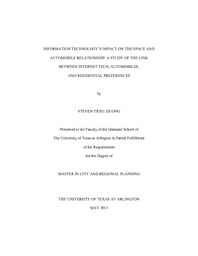| dc.description.abstract | Many city planners, developers, real estate agents, and planning academics have been strong proponents of compact, mixed-use, New Urbanist developments. They point to the research that shows that younger generations will favor the revitalized mixed use, dense, urban downtown centers advocated by urbanists like Jane Jacobs and Richard Florida over newly developed, spacious, quiet suburbs In fact, recent research on ICT and driving suggests that the advent of the smart phone and ubiquitous computing (Ubicomp) may be indeed influencing the lifestyle and preference of young adults, who rather than driving are substituting shopping, social, entertainment, and other trips with virtual trips. The question is whether this substitution of car with virtual trips would be likely to occur in dense downtown or as Joel Kotkin argues, in "smart" suburbs.Using survey data, this study explores the relationship between ICT usage, perceptions on driving, and preferences for current and future residential place -the latter operationalized in terms of New Urbanist transect zones. It tests the hypothesis that the more an individual's usage of ICT and the more negative the individual's perception of driving, the higher the individual's preference for dense urban downtowns--controlling for age and other demographic factors. Furthermore, the study hypothesizes that individuals' preferences for current versus future place of residence remain constant over time (i.e., in five, ten and twenty years preference projections).Contrary to expectations, the survey data analysis did not support the hypothesized relationships. Instead, it suggests a relationship between age and driving perceptions that is more supportive of Joel Kotkin's argument for Nerdistans and "smart suburbs." In addition, the data suggests that the preferences for future residential environments varies over time and that the majority of the Millennial generation in this study favor less dense rather than more dense, central locations. Finally, the data does not reflect any significant relationships between ICT usage and Residential Preference. | en_US |


